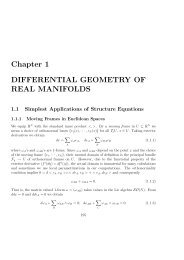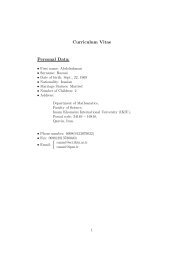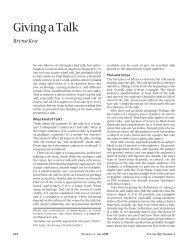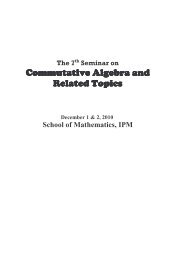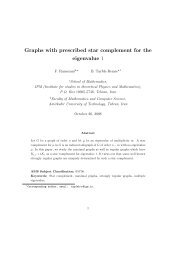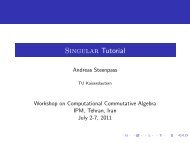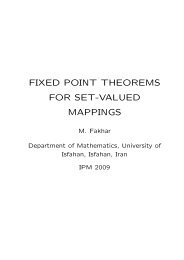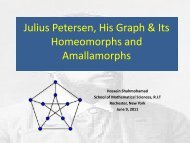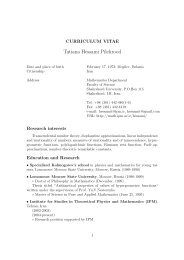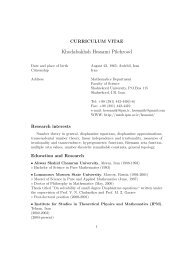1 Continuous Time Processes - IPM
1 Continuous Time Processes - IPM
1 Continuous Time Processes - IPM
You also want an ePaper? Increase the reach of your titles
YUMPU automatically turns print PDFs into web optimized ePapers that Google loves.
continuous time Markov chain as the one-sided derivative<br />
A = lim<br />
h→0+<br />
Ph − I<br />
.<br />
h<br />
A is a real matrix independent of t. For the time being, in a rather cavalier<br />
manner, we ignore the problem of the existence of this limit and proceed as<br />
if the matrix A exists and has finite entries. Thus we define the derivative of<br />
Pt at time t as<br />
dPt<br />
dt<br />
= lim<br />
h→0+<br />
Pt+h − Pt<br />
,<br />
h<br />
where the derivative is taken entry wise. The semi-group property implies<br />
that we can factor Pt out of the right hand side of the equation. We have<br />
two choices namely factoring Pt out on the left or on the right. Therefore we<br />
get the equations<br />
dPt dPt<br />
= APt,<br />
dt dt = PtA. (1.1.4)<br />
These differential equations are known as the Kolmogorov backward and forward<br />
equations respectively. They have remarkable consequences some of<br />
which we will gradually investigate.<br />
The (possibly infinite) matrices Pt are Markov or stochastic in the sense<br />
that entries are non-negative and row sums are 1. Similarly the matrix A is<br />
not arbitrary. In fact,<br />
Lemma 1.1.1 The matrix A = (Aij) has the following properties:<br />
<br />
Aij = 0, Aii ≤ 0, Aij ≥ 0 for i = j.<br />
j<br />
Proof - Follows immediately from the stochastic property of Ph and the<br />
definition A = limh→0 Ph−I<br />
. ♣ h<br />
So far we have not exhibited even a single continuous time Markov chain.<br />
Using (1.1.4) we show that it is a simple matter to construct many examples<br />
of stochastic matrices Pt, t ≥ 0.<br />
Example 1.1.1 Assume we are given a matrix A satisfying the properties of<br />
lemma 1.1.1. Can we construct a continuous time Markov chain from A? If<br />
A is an n × n matrix or it satisfies some boundedness assumption, we can in<br />
3



